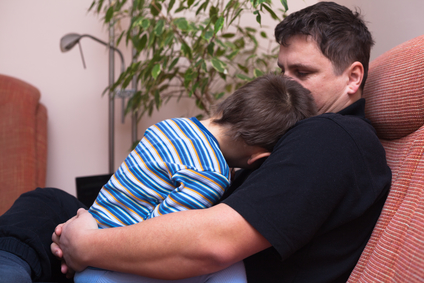The most adaptive parent-child relationships provide children with three conditions over time—an abiding message of being accepted emotionally, a sense that certain behaviors (e.g., hurting others) will not be tolerated, and values-based leadership from parents’ example and guidance. Many parents I work with have children who are behaving in defiant and disruptive ways. Parents want to know how to manage their children’s behavior and, more specifically, what kind of punishment strategies will work with a difficult child.
Research on parental discipline supports use of a three-step approach, and many parents are familiar with these three steps: instruct, warn, and sanction (or punish). Using these three steps, children learn about your expectations for specific behaviors, they’re told the consequences if expectations are not met, and they’re sanctioned if they fail to meet those expectations. Below are definitions and examples of each step.
1. Instruct
State the expectation in a clear, firm, specific, and direct manner. Change your facial expression, your posture, and your voice so your child knows that you’re now in containment mode—focused but not emotional.
e.g., “Sally, we can’t drive off till you put your seat belt on.”
2. Warn
If your child fails to follow the instruction, repeat it with a warning that lets your child know of the ensuing sanction.
e.g., “Sally, if you don’t buckle your seat belt, I’ll have to leave you here with Grandma.”
3. Sanction
If your child fails to heed the warning, impose the sanction.
e.g., “Sally, you’re going to stay here with Grandma.”
I add a 4th step to these three. This final step is probably one that is unfamiliar. I call it reconnecting because it refers to a specific kind of interaction in which parents remind children that they are valued, accepted members of the family while also remaining firm on the reasons for imposing a sanction.
It’s important for children to know that a parent is capable of restricting their behavior when necessary, even if it means a sometimes unattractive, negative conflict. But it’s also important that discipline doesn’t lead children to shut down emotionally or withdraw psychologically from parents and family.
Parents can usually sense when a difficult child is starting to grow distant from the rest of the family but they might not appreciate the risks associated with that mounting distance. I sometimes assign parents the task of reading Rudyard Kipling’s short story, “Baa Baa Blacksheep” to show how a child’s sense of alienation can lead to even more negative behavior (http://www.gutenberg.org/files/30568/30568-h/30568-h.htm#IV).
To prevent this from happening in your family, take time after a disciplinary encounter to reconnect with your children. It’s an opportunity to clarify the message behind unpleasant sanctions and to correct any misinterpretations your children might have. More importantly, post-punishment reconnecting serves to repair any emotional damage to the parent-child relationship. To reconnect is to bring your children back into the fold after they’ve been disciplined and after everyone has calmed down.
To help you get a picture of what it means to reconnect let’s go to the example of Tony, a young boy who pushed his friend Cedric. Imagine that Mom put Tony in time-out for that misdeed. Once he’s done with time-out, she can look for a chance to visit with him briefly. If he goes right back to watching TV or if he’s angry, then it’s best to wait. But later, when they’re both ready for a brief visit, I would recommend that she’d reconnect using a 3-part message. First, that Tony and his feelings are accepted. Second, that she is committed to containing his aggressive behavior. Third, that aggression is not in keeping with the values and beliefs of their family. Here’s an example of how that might sound:
Tony, I know you didn’t like being put in time-out. I could tell it made you mad. I don’t like it much either. I love you and you’re important to me and to this family. But I’m not going to let you hurt other children. Each time you push or hit, I’ll put you right back in time-out. In our family, we don’t hurt other people.
In this simple message, Tony’s mother touches on all three core conditions of a healthy parent-child relationship—accepting, containing, and leading.



Leave A Comment